
It doesn’t seem that long ago that to wrench better than 600 horsepower out of a street engine, you had to supercharge a big-block V8, take it right to the edge and then cross your fingers, making sure nothing fragile was nearby any time you wanted to risk starting it.
Shares in a fuel company didn’t hurt, either. Getting a reliable, tractable, streetable, 600-plus neddies from a small-block? Forget about it. That, of course, was then. Now, here we have a pair of cars with a combined horsepower total of more than 1300 neddies – let’s call it 1000kW in these modern times.
But more than that, they both comply fully with emissions laws (both retain their factory cat-cons, for instance) they will idle all day in 40-ambient, they’ll last for hundreds of thousands of kays and they can get their fuel consumption into the 10s, or even nines if you drive them carefully.
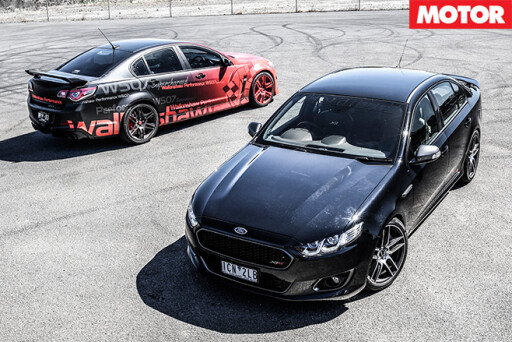 What’s going on? It’s called technology. Various types of it actually, from big advances in metallurgy, to combustion-chamber design and, of course, to computer-control of everything that could otherwise go catawampus (fuel supply, ignition curve, boost pressure, that sort of stuff).
What’s going on? It’s called technology. Various types of it actually, from big advances in metallurgy, to combustion-chamber design and, of course, to computer-control of everything that could otherwise go catawampus (fuel supply, ignition curve, boost pressure, that sort of stuff).
And an industry that has learned and adapted to maximise the extra potential inherent in these newer, better designs. Speaking of which, please stand up Walkinshaw Performance and Herrod Motorsport, because if you ever needed proof of the above, these are the guys and gals that can provide it.
What’s it like to drive a modern 500kW street car, then? Good question and I’m glad you asked, because having spent some time in both the Walkinshaw WP507 and the Herrod XR8, I’m having trouble thinking about anything else.
 Of course, not only does this pair feature all that shove, they’ve also been engineered to work in other important ways, too. Stuff like brakes and handling will always be critical areas in cars with theoretical 300km/h top whacks. You probably knew that already.
Of course, not only does this pair feature all that shove, they’ve also been engineered to work in other important ways, too. Stuff like brakes and handling will always be critical areas in cars with theoretical 300km/h top whacks. You probably knew that already.
The Walkinshaw is the least modified of these two, mainly because the basis for the WP507, the HSV GTS, has so much going on to start with. It already gets the six-pot front calipers, two-piece rotors, 20-inch wheels and tyres (ContiSport Contacts) and the selectable drive modes which control the Magnetic Ride Control settings.
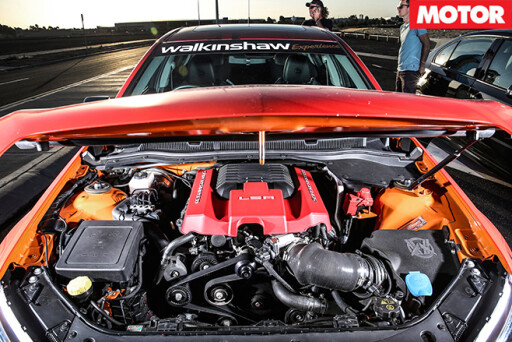 So, for your $7990 over and above a GTS automatic (not exactly a snip at $95,490) you get what is essentially an engine optimisation package that starts with a revised supercharger-drive pulley to bump boost to 12psi from the stock nine. Add the ceramic-coated headers, cat-back exhaust, cold air intake and a fiddle for the ECU, and you liberate 77 more kilowatts for a total of 507 at 6200rpm. Torque jumps to a mammoth 850Nm at 4400rpm.
So, for your $7990 over and above a GTS automatic (not exactly a snip at $95,490) you get what is essentially an engine optimisation package that starts with a revised supercharger-drive pulley to bump boost to 12psi from the stock nine. Add the ceramic-coated headers, cat-back exhaust, cold air intake and a fiddle for the ECU, and you liberate 77 more kilowatts for a total of 507 at 6200rpm. Torque jumps to a mammoth 850Nm at 4400rpm.
Robbie Herrod’s XR8, meanwhile, is a bit more extreme, purely because with a starting price of $52,490, Australia’s most enthusiastic car-tuner had more wriggle-room to begin with. So let’s break it down into the various chunks (all of which are available separately) starting with the engine.
 Herrod calls this his Stage 3 Power Pack which equates to a pulley upgrade to bump huff to around 11.5psi. While Walkinshaw is happy to work with the stock injectors and fuel system in the 6.2-litre LSX, Herrod knows from experience that the Miami 5.0-litre won’t make 500kW on its stock fuel system. So an in-house modified fuel pump goes in, as does a competition fuel regulator and a set of 1000cc high-flow injectors.
Herrod calls this his Stage 3 Power Pack which equates to a pulley upgrade to bump huff to around 11.5psi. While Walkinshaw is happy to work with the stock injectors and fuel system in the 6.2-litre LSX, Herrod knows from experience that the Miami 5.0-litre won’t make 500kW on its stock fuel system. So an in-house modified fuel pump goes in, as does a competition fuel regulator and a set of 1000cc high-flow injectors.
But the big mods don’t stop there. While the WP507 gets away without an intercooler, Herrod has developed a kit for the Miami that fits neatly between the plenum and the intake and, according to Rob, drops intake charge temps from around 65 to 40-45 degrees.
There’s an ECU tune to make each bit talk to the others and nice touches like an oil breather mod and a spark-booster kit. Herrod has also developed an exhaust system which amounts to a stainless cat-back set-up and adds $2200 to the $10,630 total for the engine mods.
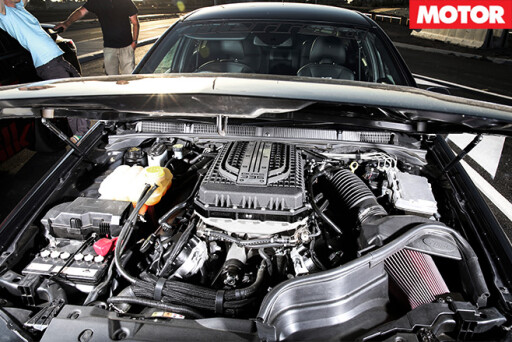 Brakes on our test car were Harrop six-potters up front with four-pots out back, grabbing 381mm and 356mm (respectively) rotors and carrying a $7200 price-tag. The rims are 19-inchers of Herrod Motorsport’s own design and wrapped in ContiSport Contacts with, crucially, a 11.5-inch (295mm) hoop on the rear end (the W507 makes do with a 275mm rear).
Brakes on our test car were Harrop six-potters up front with four-pots out back, grabbing 381mm and 356mm (respectively) rotors and carrying a $7200 price-tag. The rims are 19-inchers of Herrod Motorsport’s own design and wrapped in ContiSport Contacts with, crucially, a 11.5-inch (295mm) hoop on the rear end (the W507 makes do with a 275mm rear).
That’s been made possible by a set of Herrod-modded rear suspension blades. All that adds another $4850. There’s also a custom-calibrated spring and Koni shock package for $2380. As tested, then, the Herrod hot-rod stands as a $27,260 advance over the stock XR8 manual, taking the total to $79,750, well short of the Walky’s $103,480.
And like we said, you only want the Herrod motor, just buy the Herrod motor. Me? I’d take the motor, the brakes and the suspension and probably live with the stock wheels and tyres till it was time to replace them. Which wouldn’t be long.
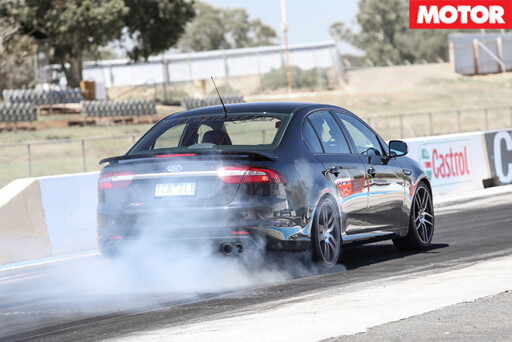 And that’s because this thing fairly rips. You think the stock 335kW of the XR8 is tough? You ain’t, as they say in the classics, seen nothin’ yet. Okay, so the quarter mile time of 13.1 seconds isn’t much more than a handful of tenths faster than a stocker, but stay with me.
And that’s because this thing fairly rips. You think the stock 335kW of the XR8 is tough? You ain’t, as they say in the classics, seen nothin’ yet. Okay, so the quarter mile time of 13.1 seconds isn’t much more than a handful of tenths faster than a stocker, but stay with me.
See, while it’s common knowledge that a dyno can lie, so can the dragstrip. Well, maybe not actually tell porky-pies, but the bald numbers from a 400-metre run can sometimes fail to tell the whole, real-world story. And that’s what’s going on here. I’ll explain in a minute.
The nub of it is that the Herrod XR8 is w-a-y faster than a stocker, but in manual form, it’s nastier than a nest of vipers when it comes to getting a clean getaway. You’ve got to puppy-walk it off the line and then be Forrest Gump-slow on the shift into second to get it back on the noise.
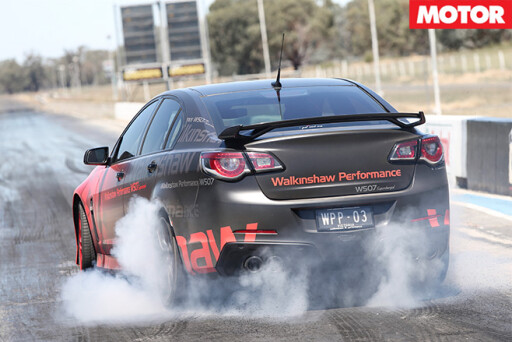 Easy does it, my friends, or she’ll go up in ContiSport smoke and axle tramp to half-track. Ugly. And slow. Do it right and those 13.1s will come. Do it perfectly (and here’s where the old-school manual park-brake comes into its own) and there could even be a high-12 lurking in there somewhere. But in three-pedal form, that’s as good as it’ll get.
Easy does it, my friends, or she’ll go up in ContiSport smoke and axle tramp to half-track. Ugly. And slow. Do it right and those 13.1s will come. Do it perfectly (and here’s where the old-school manual park-brake comes into its own) and there could even be a high-12 lurking in there somewhere. But in three-pedal form, that’s as good as it’ll get.
In contrast, the Walkinshaw is almost stupid-easy to launch. Oh, sure, you can still set fire to its tail with too much clog, but with a small stall-up the WP507 will scamper off to a 12.4 quarter-mile and do it repeatably. So it’s much quicker, no? Er, well, here’s where that dragstrip-can-deceive thing comes in.
In the interests of science, we decided to run both cars down the strip side-by-side, starting from 60km/h in second gear in each. And guess what? By eliminating the need to include a from-rest launch in proceedings, things evened up quite a bit.
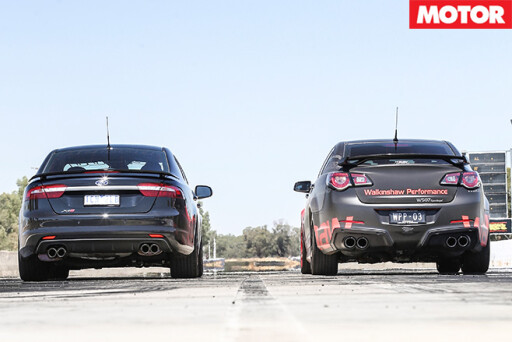 In fact, they evened up completely, and even after a few goes, our 60-kay roll-on run netted a dead-heat, even out beyond the 400m mark. You could not have put a rollie-paper between them. So the Herrod XR8 in auto form would be just as quick as the Walky then? Um, don’t go jumping to conclusions.
In fact, they evened up completely, and even after a few goes, our 60-kay roll-on run netted a dead-heat, even out beyond the 400m mark. You could not have put a rollie-paper between them. So the Herrod XR8 in auto form would be just as quick as the Walky then? Um, don’t go jumping to conclusions.
The six-speed auto in the WP507 has been tweaked for greater shift clarity, so it fair dinkum changes up like the rear end of the car has just been whacked by a huge sledgehammer. My initial suspicion was also that the tranny had been treated to a high-stall converter, and the way this trans allows the engine to spool up, build boost and then lets the car catch-up, feels just like your mate’s high-stalled 308 HZ Kingswood did back in the day. Times 10, of course.
Walkinshaw denies that it’s done any such thing (swapping the converter) so without pulling the thing apart, I have to believe that it’s just a recalibration at work here. But it has a big effect. Maybe an XR8 auto tricked to the same extent. Maybe not.
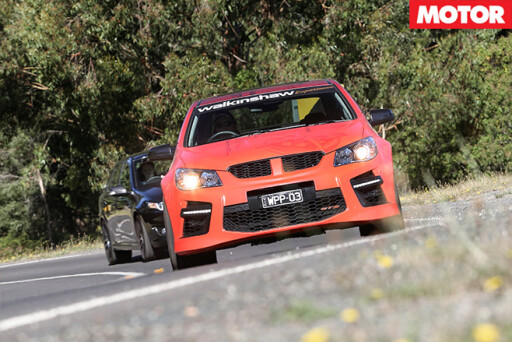 One area where there are no hairs to be split is the overtaking department. Both these cars have the ability to take you from 90km/h (usual snoozer highway cruising speed) to prison in the space it takes to get around that same 1993 Camry.
One area where there are no hairs to be split is the overtaking department. Both these cars have the ability to take you from 90km/h (usual snoozer highway cruising speed) to prison in the space it takes to get around that same 1993 Camry.
The WP507 will kick down a couple of gears and then grunt on by, while the driver of the Herrod has a choice to make: Drop three gears and leave themselves open for a lethal injection. Or, stay in sixth gear for the overtake and maybe get off light with a 20-year non-parole period.
Gunning either car away from an intersection or cross-roads out in the bush is more fun than I can tell you. Both have a bit of blower-whine as you load them up and increase the revs beyond about 3500rpm, and both have the ability to leave you open-mouthed time and time again. That’ll be 500kW, then.
 The Herrod car has a truly amazing top-end rush and almost feels like a turbo in that regard. Not that it lacks for bottom-end grunt, but the rush to 6000rpm is truly phenomenal. The Walkinshaw, by comparison, feels a bit more linear, but that just means it’s awesome everywhere.
The Herrod car has a truly amazing top-end rush and almost feels like a turbo in that regard. Not that it lacks for bottom-end grunt, but the rush to 6000rpm is truly phenomenal. The Walkinshaw, by comparison, feels a bit more linear, but that just means it’s awesome everywhere.
And thanks to those tranny tweaks we mentioned, it has that old-fashioned, speedboat-coming-out-of-the-hole thing going on. And from inside, it honestly sounds like a Doorslammer when you’re fair up it. The only question is whether, over time, you might get a bit tired of this level of extroversion.
For all that mayhem and madness, either car would be completely at home doing the interstate run, and towing a boat or caravan would involve no hardship. If anything, we’d pick the Herrod for long trips because the man has fixed the two things that let the basic XR8 down a little.
For a start, the revised springs in the rear of the Herrod Falcon have tamed that choppiness in the ride. This is big news, too, because in stock form, the Ford and the HSV have reversed roles with the GTS possessing the more supple, subtle ride.
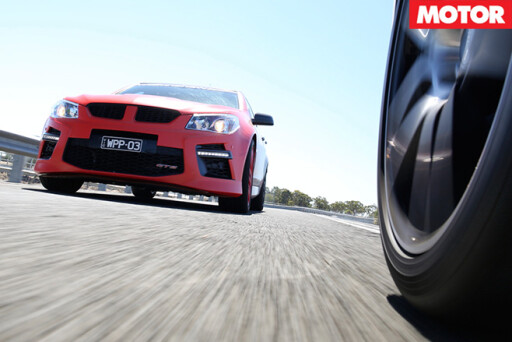 But this time round, it was the Walkinshaw that was deemed to be the more nervous one on hacked-up bitumen and those small amplitude bumps that live everywhere in Australia. Shows you what springs and shocks and a bit of nous can do.
But this time round, it was the Walkinshaw that was deemed to be the more nervous one on hacked-up bitumen and those small amplitude bumps that live everywhere in Australia. Shows you what springs and shocks and a bit of nous can do.
Another thing Herrod has fixed is the basic Falcon’s crook driving position. By re-sculpting the seat foam, there’s now more room between the tiller and the seat cushion. You finally feel as though you’re sitting in an XR8 and not on it.
The relevance of cars like this in 2015 is the other big question people tend to throw our way. But when the thing can better 10 litres per 100km on a cruise and has the usual plethora of air-bags and driver aids (the Walky even has blind-spot sensors and lane-departure warnings) it’s hard to argue that case on any level.
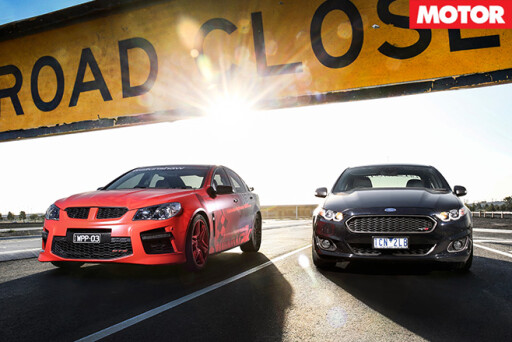 And, yes, I realise you don’t need 500kW to get to work or the shops, but trust me, if you had either of these sitting in your driveway, you’d spend a lot less time looking at Swedish websites on the internet.
And, yes, I realise you don’t need 500kW to get to work or the shops, but trust me, if you had either of these sitting in your driveway, you’d spend a lot less time looking at Swedish websites on the internet.
And in an age where I’m constantly being told to get off the lounge and get out into the world for the sake of my health, maybe a WP507 or a Herrod XR8 is just what the doctor ordered. “Mind telling me why you were speeding, sir?” “Doctor’s orders.”
| HERROD XR8 | WALKINSHAW WP507 | |
| Body | 4-door, 5-seat sedan | 4-door, 5-seat sedan |
| Drive | rear-wheel | rear-wheel |
| Engine | 4951cc V8, DOHC, 32v, supercharger | 6162cc V8, OHV, 16v, supercharger |
| Bore/Stroke | 92.2 x 92.7mm | 103.2 x 92.0mm |
| Compression | 9.25:1 | 9.1:1 |
| Power | 510kW @ 5800rpm | 507kW @ 6200rpm |
| Torque | 760Nm @ 4800rpm | 850Nm @ 4400rpm |
| Power/weight | 269kW/tonne | 275kW/tonne |
| Transmission | 6-speed manual | 6-speed auto |
| Weight | 1861kg | 1841kg |
| Suspension | double A-arms, coil springs, anti-roll bar (f); multi-links, coil springs, anti-roll bar (r) | struts, coil springs, stabiliser bar (f); multi-links, coil springs, stabiliser bar (r) |
| L/W/H | 4949/1868/1458mm | 4505/1895/1220mm |
| Wheelbase | 2650mm | 2915mm |
| Tracks | 1583/1598mm (f/r) | 1616/1590mm (f/r) |
| Steering | hydraulically-assisted rack-and-pinion | electrically-assisted rack-and-pinion |
| Brakes | 381mm ventilated discs, 6-piston calipers (f); 356mm ventilated discs, 4-piston calipers (r) | 390mm two-piece carbon ceramic rotors, 6-piston calipers (f); 350mm two-piece carbon ceramic rotors, 4-piston calipers (r) |
| Wheels | 19 x 9.0-inch (f); 19 x 10.0-inch (r) | 20 x 8.5-inch (f); 20 x 9.5-inch (r) |
| Tyres | 255/35 ZR19 96Y (f); 295/30 ZR19 100Y (r) ContiSport Contacts | 255/35 R20 (f); 275/35 R20 (r) ContiSport Contacts |
| Price | 52490 | $95,490 |
| Price as tested | $79,750* *Engine mods ($10,630); brakes ($7200); wheels and tyres ($4850); custom spring and Koni shock package ($2380); exhaust system ($2200) | $103,480* *W507 Package ($7990) |
| Positives | Fearsome engine; comfy ride; looks great; value for money | Shockingly quick; sounds gnarly; hot-rod vibe; brakes and handling |
| Negatives | Still a bit of a woolly handler; almost scary fast; power-down issues | Ride has been compromised somewhat; garish sticker package |
| 4.5 out of 5 stars | 4.5 out of 5 stars |

COMMENTS